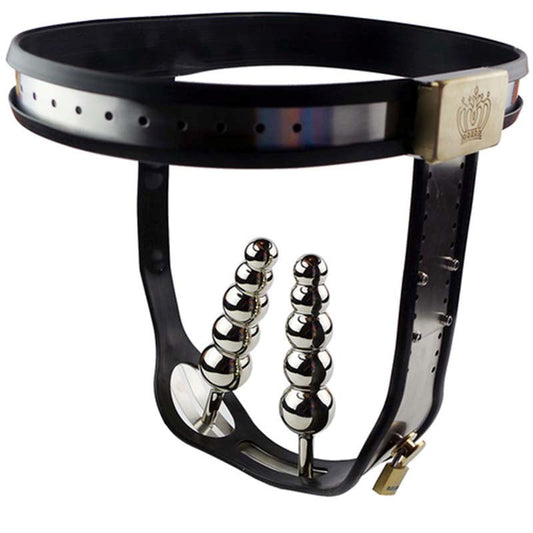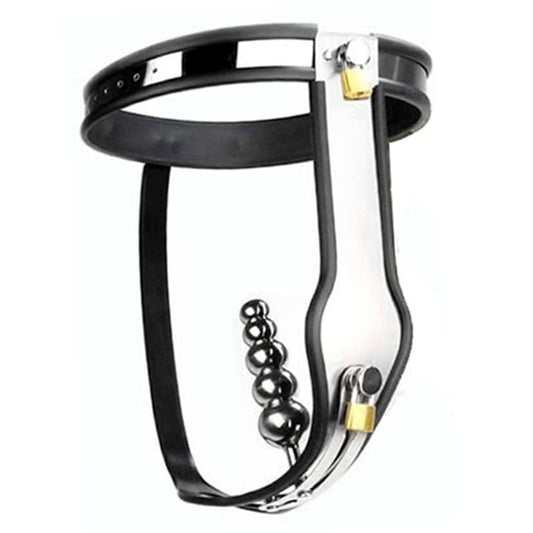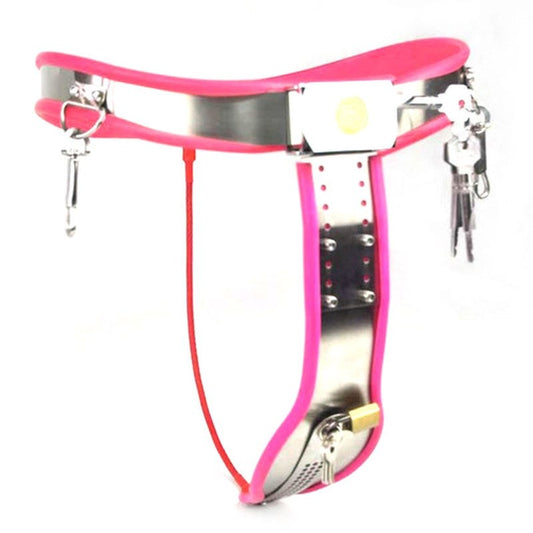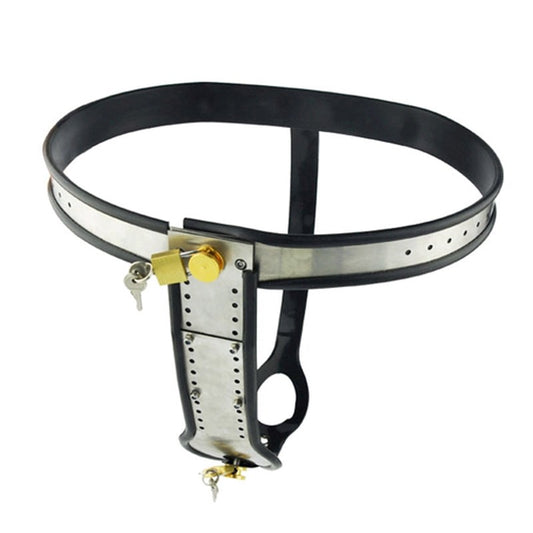-
BDStyle Female Full Body Chastity Complete Metal Restraint Control System - BlackFemale Full Body Chastity - Complete Control System BDStyle's Female Full Body Chastity system represents precision engineering in restrictive wear. This comprehensive restraint solution combines durability with adaptability, featuring interconnected components that work in harmony to create a complete control experience. Engineering and Materials...
- $499.99
- $499.99
- Unit price
- per
-
Black
-
Pink
-
BDStyle Medium Curve T Premium Female Chastity Belt with Locking Cover - BlueMedium Curve-T Premium Female Chastity Belt with Locking Cover - Embrace Control and Security The Medium Curve-T Premium Female Chastity Belt represents the pinnacle of craftsmanship in intimate control devices. Meticulously crafted from premium stainless steel, this belt delivers unmatched security while maintaining comfort...
- $199.99
- $199.99
- Unit price
- per
-
Blue
-
Black
-
White
-
Pink
-
BDStyle Locking Steel Female Chastity Belt with Adjustable Restraint SystemLocking Steel Female Chastity Belt - Premium Restraint for Dedicated Players The Locking Steel Female Chastity Belt represents the pinnacle of control and submission play, crafted specifically for enthusiasts seeking authentic BDSM experiences. This meticulously engineered restraint device combines classical design elements with modern...
- $169.99
- $169.99
- Unit price
- per
-
BDStyle Female Steel Chastity Belt & Plug Adjustable Steel DeviceExperience Premium Control and Comfort Discover the artistry of dominance with BDStyle's Female Steel Chastity Belt & Plug, a masterpiece of precision engineering designed for those who appreciate the finer aspects of power exchange. This adjustable device combines durability with sophistication, offering a secure...
- $199.99
- $199.99
- Unit price
- per
-
BDStyle Full Body Leather Harness BeltWhat is BD Style Full Body Leather Harness Belt? The BD Style Full Body Leather Harness Belt is a premium adult product designed to enhance your intimate experiences. Crafted from high-quality genuine leather, this versatile harness belt offers a firm, solid grip that contours...
- $49.99
- $49.99
- Unit price
- per
-
Dual Plug Female Chastity BeltWhat is Dual Plug Female Chastity Belt? The Dual Plug Female Chastity Belt is a versatile and innovative intimate accessory designed to enhance your intimate experiences. Crafted with high-quality materials, this chastity belt features a solid cock ring and a soft, stretchy ring that...
- $229.99
- $229.99
- Unit price
- per
-
Steel Female Chastity Belt With PlugExperience Ultimate Control with the Steel Female Chastity Belt with Plug Ready to explore the depths of power exchange and orgasm control? The Steel Female Chastity Belt with Plug offers an unparalleled combination of security, comfort, and intensity for those seeking to push their...
- $349.99
- $349.99
- Unit price
- per
-
Curve-T Premium Female Chastity Belt with Locking Cover - BlackDiscover Unparalleled Control with the Curve-T Premium Female Chastity Belt Are you ready to elevate your BDSM experiences to new heights? The Curve-T Premium Female Chastity Belt with Locking Cover offers the ultimate in security, comfort, and control for those seeking intense orgasm denial...
- $199.99
- $199.99
- Unit price
- per
-
Black
-
Blue
-
Pink
-
White
-
Female Chastity Belt With Double Vibration Plug - BlackUnlock a New Level of Pleasure and Control with the Female Chastity Belt with Double Vibration Plug Are you ready to elevate your BDSM experience to new heights? The Female Chastity Belt with Double Vibration Plug is here to revolutionize your intimate encounters. This...
- $49.99
- $49.99
- Unit price
- per
-
Black
-
Red
-
Female Chastity Belt With Plug - BlackIntroducing the Female Chastity Belt with Plug: Unlock a World of Sensual Control Ready to elevate your intimate experiences to new heights? The Female Chastity Belt with Plug offers a tantalizing blend of security, stimulation, and style for those eager to explore the thrilling...
- $199.99
- $199.99
- Unit price
- per
-
Black
-
Blue
-
Pink
-
Y Covert Palms Female Chastity DeviceEmbrace Control with the Y-Covert Palms Female Chastity Device Are you ready to explore the thrilling world of power exchange and orgasm control? The Y-Covert Palms Female Chastity Device offers a secure, comfortable, and discreet way to experience the intense anticipation and heightened desire...
- $169.99
- $169.99
- Unit price
- per
-
Forced Orgasm Belt - BlackUnleash Unbridled Pleasure: The Forced Orgasm Belt Are you ready to experience pleasure beyond your wildest dreams? The Forced Orgasm Belt isn't just a toy - it's an instrument of ecstasy that pushes the boundaries of sensation and control. Designed for those who crave...
- $49.99
- $49.99
- Unit price
- per
-
Black
-
Pink
-
Purple
-
Red
-
Model T Female Chastity BeltEmbrace Ultimate Control: The Model T Female Chastity Belt Are you ready to explore the pinnacle of power exchange and sensory denial? The Model T Female Chastity Belt isn't just a device - it's a gateway to a world of intense trust, unwavering security,...
- $169.99
- $169.99
- Unit price
- per
-
Womens Leather Chastity ThongEmbrace Seductive Control with the Women's Leather Chastity Thong Discover the perfect fusion of allure and restraint with the Women's Leather Chastity Thong. This provocative piece blends the sensuality of erotic lingerie with the thrilling control of a chastity device, creating an irresistible addition...
- $19.99
- $19.99
- Unit price
- per
Frequently Asked Questions
How do Chastity Belts For Women end up 5 mm too narrow and require tools just to remove after a test fitting?
Pick belts with modular hip plates or multi-hole side bars. These allow micro-adjustments so the waistband doesn’t lock too tight.
Why do Women’s Locking Chastity Belts leave long-lasting waistband scars that look permanently engraved?
Choose curved steel or padded waist liners. They spread pressure across the hips instead of cutting one hard groove.
What causes Female Steel Chastity Belts to dig into the crack and amplify every movement into metallic kazoo noises?
Select rear shields with softer edging or flexible hinges. These follow your body’s shape instead of pressing directly into tissue.
When do Women’s Confinement Belts trap you because the only key was destroyed in the wash?
Use dual-key or magnetic-coded locks. These give backup access without relying on a single fragile key.
How can Chastity Belts For Women still clank loudly in yoga and expose you instantly?
Pick silicone-lined frames or silent hinges. These damp metal-on-metal movement.
Why do Women’s Locking Chastity Belts trigger airport alarms and force awkward TSA explanations?
Choose lightweight alloys or partial-resin systems. They reduce metal mass and lower detector sensitivity.
What makes Female Steel Chastity Belts press on the bladder until you need to pee constantly?
Select front plates with an anatomical curve or lifted arch. These relieve bladder pressure during sitting and bending.
How do Women’s Confinement Belts trap sweat and turn the entire vulva area into a humid pocket?
Use vented crotch plates or wide airflow channels. These reduce moisture buildup and help keep skin dry.
Why do Chastity Belts For Women snap rear cables during squats and whip the labia painfully?
Switch to solid rear shields or reinforced straps. These hold tension without flexing or snapping.
Recently Viewed Products
Example product title
- $19.99
- $19.99
- Unit price
- per
Example product title
- $19.99
- $19.99
- Unit price
- per
Example product title
- $19.99
- $19.99
- Unit price
- per
Example product title
- $19.99
- $19.99
- Unit price
- per
Example product title
- $19.99
- $19.99
- Unit price
- per
Example product title
- $19.99
- $19.99
- Unit price
- per
Example product title
- $19.99
- $19.99
- Unit price
- per
Example product title
- $19.99
- $19.99
- Unit price
- per
Example product title
- $19.99
- $19.99
- Unit price
- per
Example product title
- $19.99
- $19.99
- Unit price
- per
Why Shop With Cock Ring Store?
- Choosing a selection results in a full page refresh.


















